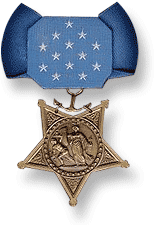List of Puerto Rican recipients of the Medal of Honor
Since World War I Puerto Ricans and people of Puerto Rican descent have participated in every conflict in which the United States has been involved as members of the United States Armed Forces. The following nine Puerto Ricans, including those of Puerto Rican descent,[note 1] have made the ultimate sacrifice and were posthumously awarded the nation's highest military decoration – the Medal of Honor. The Medal of Honor is bestowed "for conspicuous gallantry and intrepidity at the risk of life, above and beyond the call of duty, in actual combat against an armed enemy force." The medal is awarded by the President of the United States on behalf of the Congress.
| Puerto Rican recipients of the Medal of Honor | |||||||
|---|---|---|---|---|---|---|---|
|
Navy and Marine MoH • Army MoH |
| Medal of Honor |
|---|
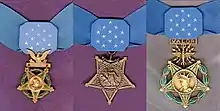 |
| All recipients |
| American Civil War |
|
| Other wars and conflicts |
|
|
| By ethnic group |
| By other criteria |
PFC Fernando Luis García was the first Puerto Rican and the only one who was a member of the United States Marine Corps to have been awarded the Medal of Honor for his actions during the Korean War. The other eight were members of the United States Army and were awarded the medal for their actions during the Korean War or the Vietnam War.
On March 18, 2014, President Barack Obama posthumously awarded the Medal of Honor to Félix Conde Falcón, Juan Negrón, Demensio Rivera and Miguel Vera. The total of Puerto Rican soldiers awarded the Medal of Honor increased to a total of nine.[1]
Medal of Honor
The Medal of Honor was created during the American Civil War and is the highest military decoration presented by the United States government to a member of its armed forces. The recipient must have distinguished themselves at the risk of their own life above and beyond the call of duty in action against an enemy of the United States. Due to the nature of this medal, it is commonly presented posthumously.[2]
Korean War
Fernando Luis García
PFC Fernando Luis García* (October 14, 1929 – September 5, 1952), born in Utuado, Puerto Rico, was a member of the United States Marines and the first Puerto Rican who was awarded the Medal of Honor.
Medal of Honor citation:
For conspicuous gallantry and intrepidity at the risk of his life above and beyond the call of duty while serving as a member of Company I, Third Battalion, Fifth Marines, First Marine Division (Reinforced), in action against enemy aggressor forces in Korea on September 5, 1952. While participating in the defense of a combat outpost located more than one mile forward of the main line of resistance during a savage night attack by a fanatical enemy force employing grenades, mortars and artillery, Private First Class Garcia, although suffering painful wounds, moved through the intense hail of hostile fire to a supply point to secure more hand grenades. Quick to act when a hostile grenade landed nearby, endangering the life of another Marine, as well as his own, he unhesitatingly chose to sacrifice himself and immediately threw his body upon the deadly missile, receiving the full impact of the explosion. His great personal valor and cool decision in the face of almost certain death sustain and enhance the finest traditions of the United States Naval Service. He gallantly gave his life for his country.[3]
In memory:
PFC Fernando Luis Garcia's remains were never recovered. There is a headstone with Garcia's name in the Puerto Rico National Cemetery in the city of Bayamon, Puerto Rico.
Juan E. Negrón
Master Sergeant Juan E. Negron*, (September 26, 1929 – March 29, 1996) born in Corozal, Puerto Rico, was posthumously awarded the Medal of Honor on March 18, 2014, for his courageous actions while serving as a member of Company L, 65th Infantry Regiment, 3rd Infantry Division during combat operations against an armed enemy in Kalma-Eri, Korea on April 28, 1951.[1]
Medal of Honor citation:
MASTER SERGEANT
JUAN E. NEGRON
UNITED STATES ARMY
For service as set forth in the following citation:
The Distinguished Service Cross is presented to Juan E. Negron (RA10406243), Master Sergeant, U.S. Army, for extraordinary heroism in connection with military operations against an armed enemy of the United Nations while serving with the 65th Infantry Regiment, 3d Infantry Division. Master Sergeant Negron distinguished himself by extraordinary heroism in action against enemy aggressor forces in the vicinity of Kalma-Eri, Korea, on 28 April 1951. On that date, Sergeant Negron took up the most vulnerable position on his company's exposed right flank after an enemy force had overrun a section of the line. When notified that elements of the company were withdrawing, Sergeant Negron refused to leave his exposed position, but delivered withering fire at hostile troops who had broken through a road block. When the hostile troops approached his position, Sergeant Negron accurately hurled hand grenades at short range, halting their attack. Sergeant Negron held the position throughout the night, while an allied counter attack was organized and launched. After the enemy had been repulsed, fifteen enemy dead were found only a few feet from Sergeant Negron's position. The extraordinary heroism exhibited by Sergeant Negron on this occasion reflects great credit on himself and is in keeping with the finest traditions of the military service.In memory:
On March 29, 1996, Negrón died in Bayamon, Puerto Rico. He was buried with military honors in Plot: J 0 3180 of the Puerto Rico National Cemetery located in the city of Bayamon.[4]
Demensio Rivera
Private Demensio Rivera*, (April 28, 1932 – March 19, 1964) born in Cabo Rojo, Puerto Rico, was posthumously awarded the Medal of Honor on March 18, 2014, for his courageous actions while serving as an automatic rifleman with 2d Platoon, Company G, 7th Infantry Regiment, 3d Infantry Division during combat operations against an armed enemy in Changyong-ni, Korea on May 23, 1951.[1]
Medal of Honor citation:
PRIVATE FIRST CLASS
DEMENSIO RIVERA
UNITED STATES ARMY
For service as set forth in the following citation:
The Distinguished Service Cross is presented to Demensio Rivera (RA12346464), Private First Class, U.S. Army, for extraordinary heroism in connection with military operations against an armed enemy of the United Nations while serving with Company G, 2d Battalion, 7th Infantry Regiment, 3d Infantry Division. Private First Class Rivera distinguished himself by extraordinary heroism in action against enemy aggressor forces at Changyong-ni, Korea, on 22 and 23 May 1951. When the outpost area occupied by his platoon was assaulted during the night, Private Rivera, an automatic rifleman, held his forward position tenaciously, although exposed to very heavy fire. With his automatic rifle, he delivered a continuous and devastating fire at the approaching enemy until this weapon became inoperative, whereupon he employed his pistol and grenades and stopped the enemy within a few feet of his position. During a renewed attack, he fought the enemy hand-to-hand and forced them back. Finally, as an overwhelming number of the enemy closed in on him, he killed four of them with his only remaining grenade, although they were in such close proximity he was severely wounded by the same explosion, When is position was retaken, he was recovered, seriously wounded, and lying with the bodies of the four enemy dead or dying. Private Rivera's fearless performance was a major factor in successfully repulsing the enemy's attacks. His unflinching courage and devotion to duty uphold the finest traditions of the military service.In memory: Rivera was residing in New York City where he died on March 19, 1967. His body was transferred to Puerto Rico. He was buried with full military honors in section C row K-184 at the Cementerio San Miguel Arcangel located in Carretera PR-308, Parcelas Puerto Real, Cabo Rojo.[4]
Miguel Armando Vera
Private Miguel Armando Vera* (May 3, 1932 – September 21, 1952) born in Adjuntas, Puerto Rico was posthumously awarded the Medal of Honor on March 18, 2014, for his courageous actions while serving as an automatic rifleman with Company F, 38th Infantry Regiment, 2nd Infantry Division in Chorwon, Korea, on September 21, 1952.[1]
Medal of Honor citation:
PRIVATE
MIGUEL A. VERA
UNITED STATES ARMY
For service as set forth in the following citation:
For extraordinary heroism in connection with military operations against an armed enemy of the United Nations, while serving with Company F, 2nd Battalion, 38th Infantry Regiment, 2nd Infantry Division. Vera distinguished himself by extraordinary heroism in action against enemy aggressor forces at Chorwon, Korea, on Sept. 21, 1952.
On that date, Vera's unit was committed to assault and secure the right sector of "Old Baldy" and, although wounded in an earlier engagement, he voluntarily rejoined elements of the platoon regrouping at the base of the hill to resume the attack. Forging up the bare, rocky slope in skirmisher formation, the troops came within twenty yards of hostile positions when they were subjected to heavy artillery and mortar barrages and intense cross-fire from automatic weapons and grenades, which forced them to move back. He selflessly remained behind to cover the withdrawal and, maintaining a determined stand, poured crippling fire into enemy emplacements. During this action he lost his life.In memory:
Vera's body was transferred to Puerto Rico where he was buried with full military honors in the Utuado Municipal Cemetery, Utuado, Puerto Rico.[4] On November 20, 2014, the remains of Korean War hero, Pvt. Vera, were moved and laid to rest at Arlington National Cemetery. The military burial ceremony took place eight months after he was upgraded to the Medal of Honor more than 60 years after he was killed in action. [5]
Vietnam War
Carlos James Lozada
PFC Carlos James Lozada* (September 6, 1946 – November 20, 1967), born in Caguas, Puerto Rico, was a member of Company A, 2nd Battalion, 503d Infantry of the 173d Airborne Brigade, United States Army who was killed in action in Vietnam and was posthumously awarded the Medal of Honor.
Medal of Honor citation:
In memory:
PFC Lozada was buried with full military honors in Long Island National Cemetery located in Farmingdale, New York. His name is located in the Vietnam Veterans Memorial Wall Panel 30E-Row 045. His name is also inscribed in "El Monumento de la Recordación" (Monument of Remembrance), dedicated to Puerto Rico's fallen soldiers and situated in front of the Capitol Building in San Juan, Puerto Rico. The Bronx honored him by naming a playground in his honor located behind 175 Willis Ave.
Félix Conde Falcón
Staff Sergeant Felix M. Conde-Falcon* (February 28, 1938 – April 4, 1969) born in Juncos, Puerto Rico was posthumously awarded the Medal of Honor on March 18, 2014, for his courageous actions while serving as an acting Platoon Leader in Company D, 1st Battalion, 505th Infantry Regiment, 3d Brigade, 82d Airborne Division during combat operations against an armed enemy in Ap Tan Hoa, Republic of Vietnam on April 4, 1969.[1]
Medal of Honor citation:
STAFF SERGEANT
FELIX M. CONDE-FALCON
UNITED STATES ARMY
For extraordinary heroism in connection with military operations involving conflict with an armed hostile force in the Republic of Vietnam, while serving with Company D, 1st Battalion, 505th Infantry, 3rd Brigade, 82nd Airborne Division:
Conde-Falcon distinguished himself by exceptionally valorous actions, April 4, 1969, while serving as platoon leader during a sweep operation in the vicinity of Ap Tan Hoa, Vietnam. Entering a heavily wooded section on the route of advance, the company encountered an extensive enemy bunker complex, later identified as a battalion command post. Following tactical artillery and air strikes on the heavily secured communist position, the platoon of Conde-Falcon was selected to assault and clear the bunker fortifications. Moving out ahead of his platoon, he charged the first bunker, heaving grenades as he went. As the hostile fire increased, he crawled to the blind side of an entrenchment position, jumped to the roof, and tossed a lethal grenade into the bunker aperture. Without hesitating, he proceeded to two additional bunkers, both of which he destroyed in the same manner as the first. Rejoined with his platoon, he advanced about one hundred meters through the trees, only to come under intense hostile fire. Selecting three men to accompany him, he maneuvered toward the enemy's flank position. Carrying a machine-gun, he single-handedly assaulted the nearest fortification, killing the enemy inside before running out of ammunition. After returning to the three men with his empty weapon and taking up an M-16 rifle, he concentrated on the next bunker. Within ten meters of his goal, he was shot by an unseen assailant and soon died of his wounds.
His great courage, his ability to act appropriately and decisively in accomplishing his mission, his dedication to the welfare of his men mark him as an outstanding leader Conde-Falcon's extraordinary heroism and devotion to duty, at the cost of his life, were in keeping with the highest traditions of the military service and reflect great credit upon himself, his unit, and the United States Army.Postscript: His Medal of Honor was an upgrade made on March 18, 2014, to his Distinguished Service Cross Medal.
Eurípides Rubio
Capt. Eurípides Rubio* (March 1, 1938 – November 8, 1966), born in Ponce, Puerto Rico, was a United States Army captain. Rubio was a member of the U.S. Army, H&H Co., 1st Battalion, 28th Infantry, 1st Infantry Division, RVN.
Medal of Honor citation:
In memory:
The U.S. Army Reserve Center in the Puerto Nuevo sector of San Juan, PR was named after Captain Eurípides Rubio. The Department of Veterans Affairs Outpatient Clinic in Ponce, PR was also named in memory of Captain Eurípides Rubio. Capt. Eurípides Rubio's name is inscribed in "El Monumento de la Recordación" (Monument of Remembrance), dedicated to Puerto Rico's fallen soldiers and situated in front of the Capitol Building in San Juan, Puerto Rico. The name Eurípides Rubio is inscribed on the Vietnam Veterans Memorial ("The Wall") on Panel 12E, Row 044. His remains are buried in the Puerto Rico National Cemetery in the city of Bayamon, Puerto Rico – Section HSA, Site 5.
Héctor Santiago-Colón
Specialist Four Héctor Santiago-Colón* (December 20, 1942 – June 28, 1968) was born in Salinas, Puerto Rico. Santiago-Colon was a member of the U.S. Army, Company B, 5th Battalion, 7th Cavalry, 1st Cavalry Division. He was posthumously presented with the Medal of Honor, during the Vietnam War for saving the lives of his comrades.
Medal of Honor citation:
In memory:
In July 1975, The Puerto Rican National Guard renamed their base "Camp Salinas", which is located close to Santiago-Colón's birth town, with the name "Camp Santiago" in his honor. He was the second Puerto Rican to be so honored. The first Puerto Rican who has a base named after him is Marine PFC Fernando Luis García. Santiago-Colón's name on the Vietnam Veterans Memorial is located at Panel 54W Line 013. Santiago-Colón's name is also inscribed in "El Monumento de la Recordación" (Monument of Remembrance), dedicated to Puerto Rico's fallen soldiers and situated in front of the Capitol Building in San Juan, Puerto Rico. His remains are buried in the Cementerio Municipal de Salinas – Salinas, Puerto Rico.
Humbert Roque Versace
Captain Humbert Roque Versace* (July 2, 1937 – September 26, 1965) born in Honolulu, Hawaii, was a United States Army Captain of Puerto Rican-Italian descent who was awarded the United States' highest military decoration – the Medal of Honor – for his heroic actions while a prisoner of war (POW) during the Vietnam War. He was the first member of the U.S. Army to be awarded the Medal of Honor for actions performed while in captivity in Southeast Asia.
Medal of Honor citation:
In memory:
On July 9, 2002, Secretary of the Army Thomas E. White and Army Chief of Staff General Eric K. Shinseki inducted Versace into the Pentagon Hall of Heroes. Versace's capture and execution was chronicled in the book Five Years to Freedom by Nick Rowe.
There is a statue with the likeness of Versace located in the Rocky Versace Plaza, made possible with a donation of $125,000 raised by the citizens of Alexandria, Virginia. On Memorial Day of 2007, Versace's name was inscribed in Puerto Rico's monument "El Monumento de la Recordacion". Versace's remains have never been recovered. His headstone at Arlington National Cemetery stands above an empty grave and can be located in the Memorial section MG-108.
El Monumento de la Recordación
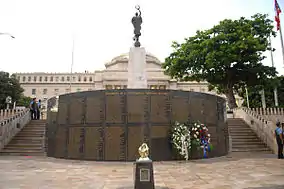
The names of the first four Puerto Rican Medal of Honor recipients were among the original inscriptions in El Monumento de la Recordación (English: Monument of Remembrance) which is dedicated to the Puerto Ricans (both those who were born in the island and/or those who were born elsewhere, but are of Puerto Rican descent) who have fallen in combat as members of the Armed Forces of the United States. Versace's inscription was subsequently unveiled by then-Senate president Kenneth McClintock and then-Speaker José Aponte. The monument, an initiative of then-Senate Majority Leader Charlie Rodríguez, erected during the Senate presidency of Roberto Rexach Benítez, is located in front of the Capitol Building of Puerto Rico in San Juan. There are paintings of each of the first four Puerto Rican Medal of Honor recipients, by the late Cuban-Venezuelan artist Estrella Díaz, inside the Capitol Building in Puerto Rico.
Medal of Honor photo gallery
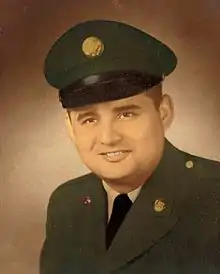 |
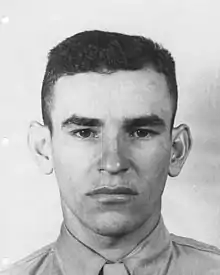 |
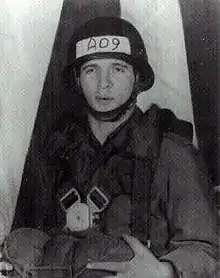 |
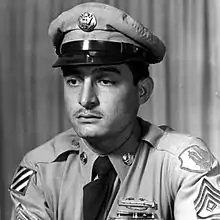 | |||||
| Conde Falcón, Félix | Garcia, Fernando Luis | Lozada, Carlos James | Negrón, Juan E. | |||||
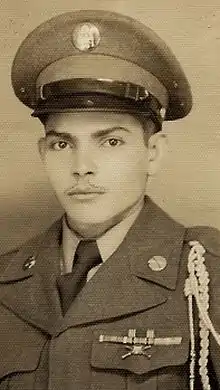 |
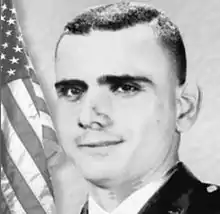 |
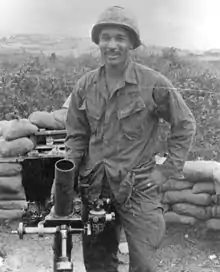 |
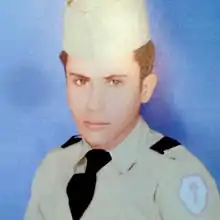 | |||||
| Rivera, Demensio | Rubio, Euripides | Santiago-Colon, Hector | Vera, Miguel | |||||
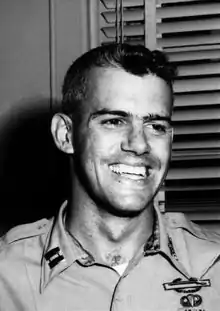 | ||||||||
| Versace, Humbert Roque | ||||||||
Notes
- N.B. An asterisk after the name indicates that the award was given posthumously.
- The Distinguished Service Cross Medal's of Juan E. Negron, Demensio Rivera, Miguel Vera and Félix Conde Falcón were upgraded to the Medal of Honor on March 18, 2014.
See also
- List of Puerto Ricans-Military
- Puerto Rican recipients of the Distinguished Service Cross
- Puerto Rican recipients of the Navy Cross
- List of Hispanic Medal of Honor recipients
- El Grito de Lares
- Intentona de Yauco
- List of Puerto Ricans
- List of Puerto Rican military personnel
- Military history of Puerto Rico
- Puerto Rican Campaign
- Puerto Ricans in World War I
- Puerto Ricans in World War II
- Puerto Ricans in the Vietnam War
- Puerto Ricans Missing in Action - Korean War
- Puerto Ricans Missing in Action - Vietnam War
- Puerto Rican Nationalist Party Revolts of the 1950s
- Puerto Rican women in the military
- 65th Infantry Regiment
- Puerto Rican recipients of the Presidential Medal of Freedom
- Puerto Rican recipients of the Presidential Citizens Medal
References
- Obama to award Medal of Honor to 24 Army veterans
- "A Brief History – The Medal of Honor". Frequently Asked Questions (FAQ). Department of Defense. August 8, 2006. Archived from the original on June 15, 2009. Retrieved February 9, 2010.
- Garcia's Medal of Honor citation Archived 2007-02-06 at the Wayback Machine
- Medal of Honor Historical Society of the United States
- https://www.arlingtoncemetery.mil/Photo-of-the-Week/Post/3176/Medal-of-Honor-Recipient-Miguel-A-Vera
- "Lozada's Medal of Honor citation". Archived from the original on 2016-03-03. Retrieved 2007-02-09.
- Rubio's Medal of Honor citation Medal of Honor citation
- Santiago-Colon's Medal of Honor citation Archived 2011-05-17 at the Wayback Machine
- Versace's Medal of Honor citation
- "Who's Who list of Marines". Who's Who in Marine Corps History. History Division, United States Marine Corps. Archived from the original on 2007-02-19. Retrieved 2008-07-24.
- "Medal of Honor recipients". Listing of Soldiers, Sailors, Airmen, Marines, and Coast Guardsmen who received the Medal of Honor during World War II. United States Army Center of Military History. July 16, 2007. Retrieved 2008-07-24.
